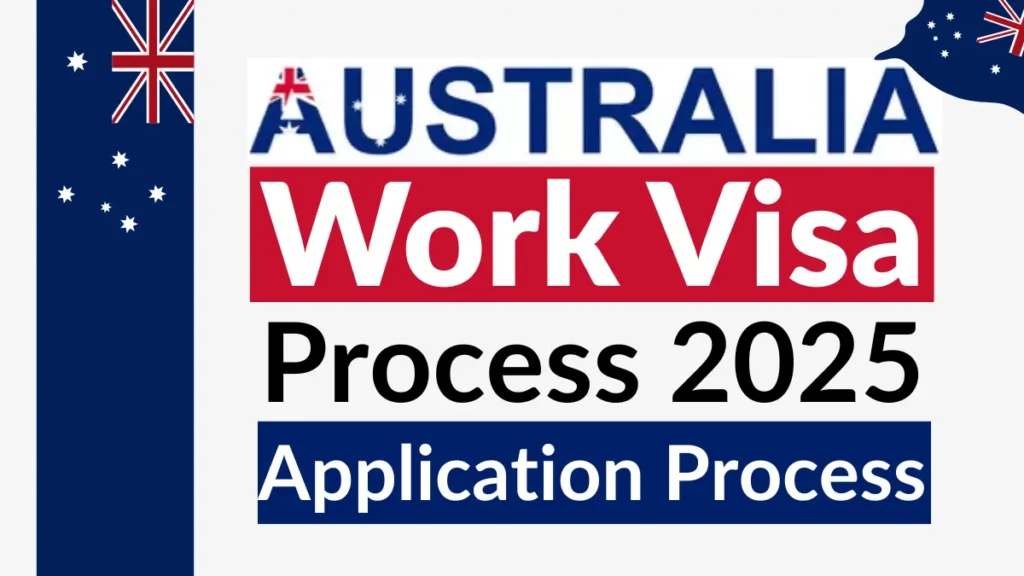
Australia continues to attract professional employees around the globe because it affords notable profession possibilities, pleasant dwelling standards and get entry to everlasting residency. However, immigration legal guidelines and visa rules are usually revised to stay relevant to the demands of the labor marketplace and the priorities of the country. In October 2025, the work visa device in Australia had new additions, in particular in the areas of abilities shortages, English language abilities, monetary capacities, and simplified utility processes. In this blog we’re going to speak about the brand new requirements, eligibility, files required and the manner through which one will be capable of applying for work visas in Australia in 2025.
Australia Work Visa
Australia has a points-based immigration regime that has been structured in such a way that it is aimed to attract professionals who can be involved in the economy. The most popular visa subclasses are:
- Temporary Skill Shortage (TSS) Visa Subclass 482: This is a type of visa class assigned to a skilled worker who is being sponsored by an employer to allow for a shortage.
- Skilled independent Visa Subclass 189: This is a visa category used to invite workers invited on the basis of points and who are not sponsored.
- Skilled Nominated Visa Subclass 190: This applies to skilled workers whom Australian states or regions have nominated to come and work in the country.
- Employer Nomination Scheme (ENS) Visa subclass 186: This visa is granted to permanent nomination workers.
- Working Holiday Visa Subclass 417/462: This visa is to allow young adults to come to Australia and work temporarily.
Such programs are revised in October 2025 to manage the increasing labor crises, particularly in the medical field, construction, IT and engineering.
Key Changes in Australia Work Visa
It has included several new regulations and conditions to make sure that Australia gets the right talent without neglecting the fair opportunities of the local workers.
Revised Points System
The skilled visa points system (Subclass 189 and 190) has also been revised to focus on those who have worked in the areas where there is a critical shortage. Additional marks are currently given on:
- Healthcare, aged care, and nursing experience.
- Developed IT and cybersecurity.
- Qualifications in construction and engineering trade.
- Regional work commitments.
Increased English Language demand
A higher degree of English proficiency will be required as of October 2025. The minimum IELTS 6.5 overall or equivalent with no less than 6.0 in a band is now required of the applicants. This transformation will guarantee integration and communication in the workplace.
Proof of Financial means
Applicants have to have better financial ability in sustaining them in the early settlement period. The minimum savings threshold has also been increased particularly to those who apply without employer sponsorship.
Priority in Sponsorship on a Regional basis
More incentives have been offered to promote skilled migration to the regional areas. Citizens who are willing to work and reside in regional Australia are given precedence in nomination and get more points.
Sponsorship of Employers.
Employers who sponsor workers on the Subclass 482 and 186 Visa have now been required to show greater adherence to the labor standards, such as fair wages and employment rights. This will make such foreign workers not to be exploited.
Occupation List Updates
A number of jobs have been included in the skilled occupation list especially those in the renewable energy sector, construction trades, healthcare, IT, and education. A few positions in the oversupplied sectors have been eliminated to equalize the demand of the labor market.
Australia Work Visa 2025 Eligibility
The new eligibility criteria of skilled workers consists of:
- At the time of application (when applying to skilled independent visas) aged under 45 years.
- Having the English language requirements.
- Meeting the points requirement (usually 65 or above) of Subclass 189/190.
- A certification of a recognized assessing authority with a valid skills assessment.
- Being on the Skilled Occupation List as to an eligible occupation.
- Presenting evidence of having enough money to cover initial settlement.
- Finding employer sponsorship (in Subclass 482 and 186).
Required Documents
To save you delays and rejections, applicants want to provide a complete package deal of documents. Common files which are required are:
- Valid passport having enough validity.
- New passport size photos.
- Certificate of Sponsorship (visas sponsored by employers).
- Assessment report of skills by a certified authority.
- Indications of educational qualifications (degrees, diplomas, transcripts).
- Evidence of related working experience (employment letters, contracts).
- Results on the English language proficiency tests (IELTS, PTE, TOEFL).
- Bank account indicating evidence of money.
- Reports regarding health examinations that are accepted by the Australian authorities.
- Police clearance certificate of every country that he/she has resided in more than 12 months.
- New CV and statement of purpose.
- Marriage or birth certificates when applying together with dependents.
Application Process
Follow the steps below to get the visa
Step 1: Eligibility test and Visa kind choice.
Outline what type of visa subclass fits your profile, the skilled unbiased (189), skilled Nominated (190), organisation subsidized (482/186), or regional. test eligibility consistent with career, age, English and paintings enjoy.
Step 2: Skills Assessment
Get a skills test of your occupation by the assessing authority. This proves that you are qualified and with experience according to the Australian standards.
Step 3: Get the EOI.
while the usage of points-based visas, e.g. Subclass 189 and a hundred ninety, you may submit an Expression of interest the use of the SkillSelect machine. This describes your qualification, abilities and revel in. Those who score high are asked to apply.
Step 4: Obtain State nomination or employer Sponsorship.
When you are applying in the Subclass 190, you must have a nomination by an Australian state or territory. In the case of Subclass 482 or 186, you have to be sponsored and issued with a Certificate of Sponsorship by your employer.
Step 5: Find the Documents to be filled.
Gather all the papers, skills evaluations, evidence of English, financial statements, medical insurance and police certificates. Make sure that all is translated and certified, where necessary.
Step 6: Online Visa Application.
Filled in the online visa form by using the official site of Australia. Post a scanned copy of all documents needed including evidence of identity, qualification and sponsorship information.
Step 7: Pay Visa Fees
Make payment of the visa application fee. The fees depend on subclass, type of applicant (primary or dependent) and either internal or external application to Australia.
Step 8: Checks of Health and Character.
Medical examination verified by the Australian panel of doctors and provide police clearance certificates to verify a good character.
Step 9: Wait for Processing
The time taken to process also depends on the subclass of visa. Independent visas that are skilled tend to be long, since they are in demand, and therefore employer-sponsored visas can be shorter, provided priority exists.
Step 10: Receive Visa Grant
With its approval, you will get a visa grant letter outlining conditions, validity and entry information. This will enable you to travel and get a job in Australia.
Work Visa Duration and validity.
- Subclass 482: 2 to 4 years based on occupation.
- Subclass 186: permanent residence.
- Subclass 189: Permanent residency.
- Subclass 190: State commitments permanent resid.
- Working Holiday Visa: 1 year, with some conditions of extension.
Benefits of New Changes in 2025
- The shortage areas of skilled workers stand a better chance of approval.
- Regional employees are able to get more prompt processing and enhanced incentives.
- Greater safeguards on exploitation by employer compliance regulations.
- More precise rules on financial documentation guarantee easier settlement.
- Adjusted occupation list is a manifestation of actual labor market demand.
FAQs
What will be the new English requirement of 2025?
The minimum overall IELTS 6.5, with no less than 6.0 bands, or a PTE/TOEFL equivalent, is now required of the applicants.
Is it possible to apply without being sponsored by the employer?
Yes, when you apply under Subclass 189 (Skilled Independent) or Subclass 190 (State Nominated) of the act, then you do not need employer sponsorship.
What amount of money do I require to demonstrate my evidence of funds?
The minimum savings that the applicants must demonstrate have increased, and usually must be sufficient to sustain them in Australia over a period of 6-12 months. The precise number depends on visa subclass, and family size.
What jobs will be highly demanded in 2025?
There is a high demand among healthcare experts, engineers, IT experts, teachers, and construction trade workers.
Is it possible to take my family on a work visa?
Yes, there are most subclasses of work visas where the spouse and dependent children can also accompany the primary applicant.
The processing time of a visa?
Processing times vary. The employer-sponsored visa can take 2-6 months, and a skilled independent visa can also take 6-12 months as per the demand.
Am I Eligible to renew my Temporary Skill Shortage Visa?
Yes, Subclass 482 visa can be extended and in certain circumstances it gives an option of getting permanent residency under Subclass186.
Are there any impact of the new changes on permanent residency pathways?
No, long-term residency may still be obtained under the Subclass 189, 190, and 186 visas, however there have been stricter language and financial capacity requirements.
Sum Up
The changes in the Australia Work Visa that will be implemented in October 2025 show that the country aims to invest in the attraction of skilled employees and balance the requirements of the labor markets. The new system will require a greater preparation on the part of the applicants with a new points system, increased English language requirements, more stringent financial evidence and new occupation lists. Nevertheless, the advantages are very high: the right to high-paying employment, the chances to obtain permanent residence, and the possibility to settle family members.
